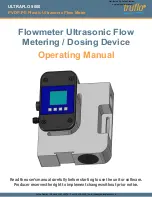
AHRS400 Series User’s Manual
Doc# 7430-0004-01 Rev. A
Page 9
The DMU rate sensor, magnetometer, and angle analog outputs are
not
enabled in this mode. Only the linear accelerometer analog outputs on pins
5 - 7 are enabled because these signals are taken directly from the
accelerometers. See the “Analog Output” section for a complete description
of the analog outputs.
3.4.2
Scaled Sensor Mode
In scaled sensor mode, the analog sensors are sampled, converted to digital
data, temperature compensated, corrected for misalignment, and scaled to
engineering units. The digital data represents the actual value of the
quantities measured. A calibration table for each sensor is stored in the
DMU non-volatile memory. A single data packet can be requested using a
serial poll command or the DMU can be set to continuously output data
packets to the host. The data is sent as signed 16-bit 2’s complement
integers. In this mode, the DMU operates as a nine-axis measurement
system.
The scaled sensor analog outputs are enabled in this mode. Note that
stabilized pitch, roll, and yaw angles are not available in scaled sensor
mode. See the “Analog Output” section for a complete description of the
analog outputs.
To convert the acceleration data into G’s, use the following conversion:
accel = data*
(
GR *
1.5)/2
15
where
accel
is the actual measured acceleration in G’s,
data
is the digital
data sent by the DMU, and
GR
is the G Range for your DMU. (The data is
scaled so that 1 G = 9.80 m s
-2
.) The G range of your DMU is the range of
accelerations your DMU will measure. For example, if your DMU uses a ±
2 G accelerometer, then the G range is 2.
To convert the angular rate data into degrees per second, use the following
conversion:
rate = data*
(
AR*
1.5)/2
15
where
rate
is the actual measured angular rate in
°
/sec,
data
is the digital
data sent by the DMU, and
AR
is the Angular rate Range of the DMU. The
angular rate range of your DMU is the range of angular rates your DMU
will measure. For example, if your DMU uses ± 150
°
/s rate sensors, then
the
AR
range is 150.
To convert the acceleration data into Gauss, use the following conversion:
mag = data*
(
MR*
1.5)/2
15
where
mag
is the actual measured magnetic field in Gauss,
data
is the
digital data sent by the DMU, and
MR
is the Magnetic field Range of the
DMU.
MR
is 1.25 for the AHRS.
SUNSTAR传感与控制 http://www.sensor-ic.com/ TEL:0755-83376549 FAX:0755-83376182 E-MAIL:[email protected]
SUNSTAR自动化 http://www.sensor-ic.com/ TEL: 0755-83376489 FAX:0755-83376182 E-MAIL:[email protected]
















































